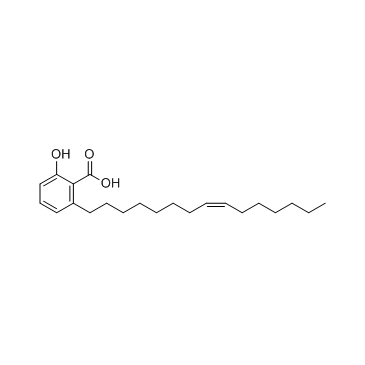Ginkgolic acid C15:1

Ginkgolic acid C15:1 structure
|
Common Name | Ginkgolic acid C15:1 | ||
|---|---|---|---|---|
| CAS Number | 22910-60-7 | Molecular Weight | 346.504 | |
| Density | 1.0±0.1 g/cm3 | Boiling Point | 492.1±40.0 °C at 760 mmHg | |
| Molecular Formula | C22H34O3 | Melting Point | 136-137ºC | |
| MSDS | Chinese USA | Flash Point | 265.5±23.8 °C | |
| Symbol |

GHS07 |
Signal Word | Warning | |
|
Design and evaluation of anacardic acid derivatives as anticavity agents.
Eur. J. Med. Chem. 43 , 1315-20, (2008) On the basis of antibacterial anacardic acids, 6-pentadecenylsalicylic acids, isolated from the cashew apple, Anacardium occidentale L. (Anacardiaceae), a series of 6-alk(en)ylsalicylic acids were synthesized and tested for their antibacterial activity agains... |
|
|
Cytotoxicity of ginkgolic acid in HepG2 cells and primary rat hepatocytes.
Toxicol. Lett. 187(3) , 131-6, (2009) Ginkgolic acids and related alkylphenols (e.g. cardanols and cardols) have been recognized as hazardous compounds with suspected cytotoxic, allergenic, mutagenic and carcinogenic properties. To determine whether the phase I metabolism could contribute to thei... |
|
|
Identification of TRIML2, a novel p53 target, that enhances p53 SUMOylation and regulates the transactivation of proapoptotic genes.
Mol. Cancer Res. 13(2) , 250-62, (2015) The tumor-suppressor protein p53, encoded by TP53, inhibits tumorigenesis by inducing cell-cycle arrest, senescence, and apoptosis. Several genetic polymorphisms exist in TP53, including a proline to arginine variant at amino acid 72 (P72 and R72, respectivel... |
|
|
Simultaneous quantification of flavonol glycosides, terpene lactones, biflavones, proanthocyanidins, and ginkgolic acids in Ginkgo biloba leaves from fruit cultivars by ultrahigh-performance liquid chromatography coupled with triple quadrupole mass spectrometry.
Biomed Res. Int. 2013 , 582591, (2013) On the basis of liquid chromatography coupled with triple quadrupole mass spectrometry working in multiple reaction monitoring mode, an analytical method has been established to simultaneously determine flavonol glycosides, terpene lactones, biflavones, proan... |
|
|
[Studies on supercritical CO2 fluid extraction for ginkgolic acids in the epicarp of Ginkgo biloba].
Zhong Yao Cai 26(6) , 428-9, (2003) The technology of supercritical CO2 fluid extraction for ginkgolic acids in the epicarp of Ginkgo biloba L. was studied. The effect of pressure, temperature and extraction time on the yield of the ginkgolic acids was explored. The optimum conditions for super... |
|
|
Ginkgolic acid inhibits protein SUMOylation by blocking formation of the E1-SUMO intermediate.
Chem. Biol. 16(2) , 133-40, (2009) Protein modification by small ubiquitin-related modifier proteins (SUMOs) controls diverse cellular functions. Dysregulation of SUMOylation or deSUMOylation processes has been implicated in the development of cancer and neurodegenerative diseases. However, no... |
|
|
Production of monoclonal antibody against ginkgolic acids in Ginkgo biloba Linn.
Am. J. Chin. Med. 32(1) , 33-48, (2004) A competitive enzyme-linked immunosorbent assay (ELISA) for ginkgolic acids (GAs) was developed using monoclonal antibody (MAb) 9F raised against 6-(13-formylheptyl) salicylic acid covalently coupled to bovine serum albumin (BSA). ELISA, at an effective measu... |
|
|
Structural elucidation of metabolites of ginkgolic acid in rat liver microsomes by ultra-performance liquid chromatography/electrospray ionization tandem mass spectrometry and hydrogen/deuterium exchange.
Rapid Commun. Mass Spectrom. 23(13) , 1899-906, (2009) Ginkgolic acids have been shown to possess allergenic as well as genotoxic and cytotoxic properties. The question arises whether the metabolism of ginkgolic acids in the liver could decrease or increase their toxicity. In this study, the in vitro metabolism o... |
|
|
Anti-Toxoplasma gondii activity of GAS in vitro.
J. Ethnopharmacol. 118(3) , 503-7, (2008) The sarcotesta of Ginkgo biloba is a Chinese herbal medicine used for treating toxoplasmosis, a serious disease requiring treatment with antibiotics that can have serious side effects.To investigate the anti-Toxoplasmagondii activity of ginkgolic acids (GAs) ... |
|
|
Effects of Ginkgo biloba constituents on fruit-infesting behavior of codling moth (Cydia pomonella) in apples.
J. Agric. Food Chem. 59(20) , 10879-86, (2011) Codling moth, Cydia pomonella (L.), is a cosmopolitan pest of apple, potentially causing severe damage to the fruit. Currently used methods of combating this insect do not warrant full success or are harmful to the environment. The use of plant-derived semioc... |